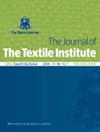硅氧烷增强栀子黄在棉花上的染色性能
IF 1.5
4区 工程技术
Q2 MATERIALS SCIENCE, TEXTILES
引用次数: 0
摘要
摘要将十甲基环五硅氧烷(D5)加入到棉织物栀子黄染色过程中,以改善其染色性能。考察了D5用量、媒染剂用量、染色温度和染色时间对染色性能的影响。结果表明,棉织物在硅氧烷基介质上的最佳染色工艺为:D5用量94%vol,染料用量2% (o.w.f),明矾为媒染剂用量3% (o.w.f),染色温度80℃,染色时间40 min。与水染色相比,D5/水染色棉织物的色强(K/S值)和细度均有所提高。通过对染色曲线的拟合,发现栀子黄在D5中对棉花的染色机理符合准二级动力学模型,与在水中的染色动力学相似。由于D5的存在,栀子黄在初始染色过程中迅速吸附在棉纤维上,然后在染料液与纤维之间染料浓度差异所产生的扩散力的驱动下与棉纤维发生扩散反应。此外,棉织物用D5/水染色的色牢度与用水染色的色牢度相等。该染色技术极大地减少了染色废水,在天然染料中具有潜在的应用前景。本文作者感谢福建省自然科学基金对外合作项目(No. 2022I0042)、福建省中青年教师教育研究项目(No. 2022I0042)的资助。JT180376),泉州市科技计划项目(2019C014R)。披露声明作者未报告潜在的利益冲突。本文章由计算机程序翻译,如有差异,请以英文原文为准。
Enhanced dyeing properties of gardenia yellow on cotton with siloxane-based medium
AbstractDecamethyl cyclopentasiloxane (D5) was devoted to the medium in the dyeing process of gardenia yellow on cotton fabric to improve the dyeing properties. The effects of D5 percentages and mordants, dyes dosage as well as dyeing temperature and time on dyeing properties were investigated. The results show that optimal dyeing processes of gardenia yellow on cotton in a siloxane-based medium are as follows: D5 percentages 94%vol, dye dosage 2% (o.w.f), alum as mordant dosage 3% (o.w.f), dyeing temperature 80 °C, dyeing time 40 min. Compared with water dyeing, cotton fabrics dyeing with D5/water present enhanced color strength (K/S value) and fine levelness. By fitting the dyeing curves, it is found that dyeing mechanism of gardenia yellow on cotton in D5 follows a pseudo-second-order kinetics model, which is alike to the dyeing kinetics in water. Owing to the hatred of D5, gardenia yellow is rapidly absorbed on the cotton fiber in initial dyeing process, then diffuses and reacts with cotton, which is drived by the diffusive force inducing by the concentration differences of dyes between dye liquor and fiber. In addition, the color fastness of cotton fabrics dyeing with D5/water is equal to that dyeing with water. This dyeing technique that immensely reduces dyeing wastewater has potential application in natural dyestuffs.Keywords: Gardenia yellowD5dyeing kineticscolor strengthcolor fastness AcknowledgmentsThe authors are grateful for the financial support provided by Fujian External Cooperation project of Natural Science Foundation (No. 2022I0042), Fujian Young and Middle-aged Teachers Education research project (No. JT180376), and Quanzhou City Science & Technology Program of China (No. 2019C014R).Disclosure statementNo potential conflict of interest was reported by the authors.
求助全文
通过发布文献求助,成功后即可免费获取论文全文。
去求助
来源期刊

Journal of the Textile Institute
工程技术-材料科学:纺织
CiteScore
4.20
自引率
5.90%
发文量
149
审稿时长
1.0 months
期刊介绍:
The Journal of The Textile Institute welcomes papers concerning research and innovation, reflecting the professional interests of the Textile Institute in science, engineering, economics, management and design related to the textile industry and the use of fibres in consumer and engineering applications. Papers may encompass anything in the range of textile activities, from fibre production through textile processes and machines, to the design, marketing and use of products. Papers may also report fundamental theoretical or experimental investigations, including materials science topics in nanotechnology and smart materials, practical or commercial industrial studies and may relate to technical, economic, aesthetic, social or historical aspects of textiles and the textile industry.
All published research articles in The Journal of The Textile Institute have undergone rigorous peer review, based on initial editor screening and anonymized refereeing by two expert referees.
 求助内容:
求助内容: 应助结果提醒方式:
应助结果提醒方式:


